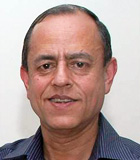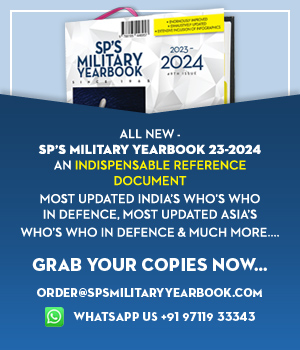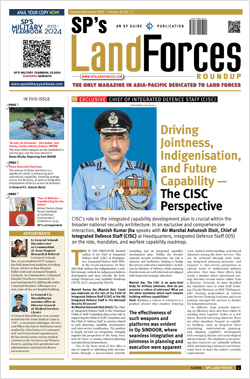INDIAN ARMED FORCES CHIEFS ON OUR RELENTLESS AND FOCUSED PUBLISHING EFFORTS

The insightful articles, inspiring narrations and analytical perspectives presented by the Editorial Team, establish an alluring connect with the reader. My compliments and best wishes to SP Guide Publications.

"Over the past 60 years, the growth of SP Guide Publications has mirrored the rising stature of Indian Navy. Its well-researched and informative magazines on Defence and Aerospace sector have served to shape an educated opinion of our military personnel, policy makers and the public alike. I wish SP's Publication team continued success, fair winds and following seas in all future endeavour!"

Since, its inception in 1964, SP Guide Publications has consistently demonstrated commitment to high-quality journalism in the aerospace and defence sectors, earning a well-deserved reputation as Asia's largest media house in this domain. I wish SP Guide Publications continued success in its pursuit of excellence.
- Appointments Committee of Cabinet approves one-month extension in service of Chief of the Army Staff
- Prime Minister witnesses 'Bharat Shakti' – a Tri-Services Firing and Manoeuvre Exercise in Pokhran, Rajasthan
- Interim Defence Budget 2024-25 — An Analysis
- Union Defence budget 2024
- Indian Army: In quest of greater firepower and policy recommendations for gaps
- Indian Army Annual Press Conference 2024
- Tata Boeing Aerospace Delivers 250 AH-64 Apache Fuselages, Manufactured in India
Rudra Brigades & Bhairav Commando Units
This transformation-cum-modernisation enhances deterrence and response capabilities against collusive threats from China and Pakistan by enabling integrated, rapid, and technologically sophisticated battlefield manoeuvres
 |
The Author is Former Director General of Information Systems and A Special Forces Veteran, Indian Army |

Integrated Battle Groups (IBGs) of the India Army have been in the news from the time raising of the Mountain Strike Corps was sanctioned, commenced raisings and then stalled. IBGs became the preferred choice for operations in the contested mountainous environment along our northern borders but little happened in this regard. IBGs should also have been the logical choice against Pakistan, especially in the plains and desert sectors, but all that happened over the decades was integration of Mechanised Brigades in select Infantry Divisions.
IBGs were originally conceived concurrent to the Army's 'Cold Start' doctrine; division-sized formation combining infantry, armour, air defence, logistics, and attack helicopters – for rapid punitive strikes under a nuclear overhang before the enemy could respond or escalate. The first CDS, General Bipin Rawat advocated deploying IBGs against China and Pakistan, as part of the Army's 2018 Land Warfare Doctrine. But the projects remained on paper amid red tape and controversies. The IBG model dispensed with Brigadier rank offices. Furore also arose with Rawat publicly calling the Indian Air Force (IAF) a "support force" while discussion on theaterisation of the Indian military was ongoing.
The Rudra Brigades represent a transformative step in modernising the operational capabilities of the Indian Army
Now during the Kargil Vijay Diwas ceremony on July 27, 2025, the Chief of Army Staff General Upendra Dwivedi announced the concept of new 'Rudra' Brigades, highlighting their design for rapid, coordinated multi-axis offensives consistent with the Cold Start Doctrine and the ongoing modernisation. The concept of Rudra Brigades is no different from that of IBGs; having fast and future-ready formations to revolutionise border warfare. The plan is to convert the Indian Army's some 250 single-arm brigades (mostly of infantry or artillery) into self-contained, multi-arm brigades with enhanced firepower, situational awareness, and logistical efficiency.
The Rudra Brigades represent a transformative step in modernising the operational capabilities of the Indian Army; since these brigades will be all-arms integrated formations that combine various combat elements, including the infantry, mechanised infantry, armoured units, artillery, special forces, and unmanned aerial systems, into a single cohesive unit supported by dedicated logistics and combat support. Such integration allows the Rudra Brigades to deliver swift, flexible, and technology-enabled responses to diverse border scenarios without requiring additional troop deployments.
These brigades will be all-arms integrated formations that combine various combat elements, including the infantry, mechanised infantry, armoured units, artillery, special forces, and unmanned aerial systems, into a single cohesive unit supported by dedicated logistics and combat support.
Composition of each Rudra Brigade would vary depending on its operational environment. For example, Rudra brigades deployed in plains may emphasise mechanised infantry, armour, and self-propelled artillery for high-speed offensive operations, whereas mountain brigades will feature infantry and artillery units better suited for high-altitude combat. Special Forces elements may also be included in specific border sectors like the Line of Control (LoC).
The Rudra Brigades will be complemented with the new 'Bhairav' Light Commando Battalions – by restructuring existing 'Ghatak' platoons of infantry battalions. Bhairav Battalions will be agile and lean tactical units focused on rapid strikes and quick border deployments, designed to create shock impact rather than deep strategic operations. Both the Rudra Brigades and the Bhairav Light Commando Battalions signify a shift to future-ready warfare dominated by digitisation, drone surveillance, automation, and precision weaponry, enabling faster decision-making and operational mobility.
Such integration allows the Rudra Brigades to deliver swift, flexible, and technology-enabled responses to diverse border scenarios without requiring additional troop deployments.
Establishment of the Rudra Brigades is a transformative step, in line with the requirements of the modern-era battlefield and suiting the operational environment along our borders with China and Pakistan, encompassing the following:
- All-Arms Integration - infantry, mechanised units, armour, artillery, special forces, and UAVs operate under one brigade command for seamless coordination;
- Rapid Deployment and Flexibility - formations tailored to terrain and mission enable swift offensive or defensive actions;
- Technology Enabled Warfare – employment of drone surveillance, area saturation weapons, and precision-guided munitions increase battlefield effectiveness;
- Embedded Combat Support and Logistics - dedicated combat support and logistics allows operational independence and sustained operations;
- Aligned with the Modern Doctrines - builds on the Cold Start Doctrine enabling multi-axis attacks;
- Force Efficiency - converts existing brigades rather than relying on new manpower, optimising use of resources;
- Strategic Impact - enhances deterrence and quick reaction capacities on India's vulnerable borders with both China and Pakistan.
At the Kargil Vijay Diwas ceremony, the COAS General Dwivedi said, "Rudra, all of the brigade, is being established for which I gave approval yesterday. Under this, we will have infantry, mechanised infantry, armoured units, artillery, special forces and unmanned aerial units at one place to provide logistics and combat support." The Indian Army has reportedly already converted two of its infantry brigades, which are deployed on the border, into Rudra brigades. The Rudra brigades include components such as infantry, mechanised infantry, tanks, artillery units, special forces and unmanned aerial systems.
The Rudra Brigades will be complemented with the new 'Bhairav' Light Commando Battalions – by restructuring existing 'Ghatak' platoons of infantry battalions.
General Dwivedi further said, "We are driven towards becoming a developed, modern and futuristic power. A new brigade is being established, and I approved it yesterday. This will have fighting components like mechanised infantry, armoured units, artillery, special forces with logistic and combat support... Special forces have also been established that will always be ready to shock the enemy on the border." He emphasised that the creation of the new Rudra and Bhairav units will increase the potential of the force manifold.
Finally, the above transformation-cum-modernisation enhances deterrence and response capabilities against collusive threats from China and Pakistan by enabling integrated, rapid, and technologically sophisticated battlefield manoeuvres. The Rudra Brigades and Bhairav battalions thus embody the Indian Army's vision of a modern, agile, and lethal force prepared to meet evolving security challenges on multiple fronts simultaneously. As part of the plan, 250 single-arm brigades (over 3,000 soldiers each) are now being converted to all-arms ones with integration of fighting elements, backed by customised logistics and combat support. It remains to be seen whether these Rudra Brigades imply region/theatre specific troops, will the components be turned over to other theatres as well, how will this affect the feeding of manpower to the Rashtriya Rifles (RR) formations/units; and above all will they will have tactical autonomy to act at all.





